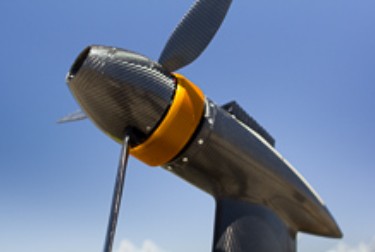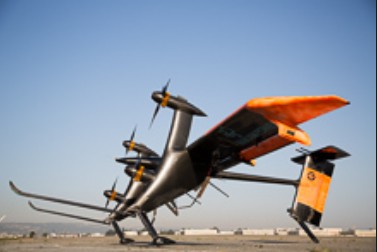Jul
19
Airborne Wind Turbine Development Makes Progress
July 19, 2013 | 5 Comments
News that Google recently bought flying wind turbine manufacturer Makani, whose planes fly between 800 and 1,950 feet, has surged a bit more energy into the airborne wind turbine research effort.
The turbine could be ‘flown’ at perhaps as high as 2000 meters in the air, taking advantage of stronger winds and cutting infrastructure costs with ideas offering multiple turbines on an airframe.
Getting up away from the ground allows airborne wind turbines access to the enormous volume of wind that is beyond the reach of traditional turbines, while cutting out the need for the huge structures and foundations that can make the current models expensive and difficult to transport. The range where wind turbines can operate is also increased, as winds aloft are a very different thing than close to the ground.
So far no single design has dominated the nascent airborne turbine scene. The best designs with worthy efficiency swoop quickly through the air, like a kite or a glider, and are tethered to the ground using a long cable. Those are known as crosswind models that can reach a much higher altitude than the heavy structures of a traditional ground tower turbine will allow. Airborne wind turbines have already been developed to operate at 600 meters, compared to the average 120 meters of a standard turbine.
Getting airborne to higher altitude offers huge benefits with access to faster winds, which has a dramatic effect on the power output of the turbines.
Oliver Woodford an engineer at Toshiba Research Europe Limited, presenting the latest research to an audience at Bath University remarked. “The faster this device goes through the wind, the power will increase with the cube of that speed, so there really is a real benefit to going faster.”
The range and wind speed factors add up to an amazing difference. The untapped wind resources that this opens up are enormous. According to a paper published in Nature last year, wind turbines placed on the earth’s surface can only extract energy at a rate of 400 Terra Watts (TW), while high altitude wind power can provide at least 1800 TW.
In an effort to recruit the environmental folks the forecast has it that extracting energy at this level would have a profound impact on the climate, but harnessing the 18TW of power globally in demand each year is unlikely to have any substantial side effects. Yet geophysically speaking, there is nothing to suggest that these devices cannot be rolled out on a grand scale.
The crosswind models have different ideas on how best to harness the kinetic energy of the wind to generate electricity.
Lift-based systems generate power by reeling the turbine in and out on its tether, passing it into a generator at ground level. The PowerPlane® built by Ampyx is an example of this type of technology. Ampyx founder Richard Ruiterkamp hopes it will be on the market by the end of 2015.
With drag-based systems, such as the one being developed by Makani, the Californian start up company recently acquired by Google, power is captured through a series of small turbines installed on the larger rigid wing, and passed through the tether to the ground.
The notion of having lots of smaller turbines was adopted on the basis that most of the power generation happens in the tips of the blades, where the velocity is fastest.
Woodford explains, “If you get rid of all the structure and just have the tip of the turbine blade, you save a lot of unwanted structure.”
Reducing this structure means that wind becomes a more viable option for future power generation, because not only does it lower the cost and carbon footprint of construction, but it also makes it easier to transport over land to areas that the typical cumbersome turbine would not be able to reach.
There are also more opportunities to construct them out at sea, since all they require is a buoyant platform moored to the seabed. One developer, SkySails, has suggested that depths up to 700 meters should be possible.
Although, like a typical turbine, the wind will have to reach a minimum speed before they can be put to use, the power supply of an airborne turbine will be more reliable because of its ability to harness higher density wind areas.
“Because you’re going higher, more often that wind speed will be met,” explains Woodford. “They are going to be more frequently operational, so you’re going to have more consistent power supply.”
Of course each model has certain drawbacks, such as problems with control or durability. But for the most part the problems concern the economics and regulatory limitations of their production. After all, this is literally ground breaking technology and the airborne wind turbines will occupy the same airspace as airplanes and airliners.
Ruiterkamp says, “For a new technology, there are quite substantial entry barriers in the energy market. We think our first installations will be funded and owned by Ampyx Power itself.
Stephan Wrage, the managing director of SkySails, said that the company has “already has invested approximately €50m in the kite technology. Nevertheless, significant amounts (€15m and more) are necessary to further develop the technology for power production in the megawatt-scale.”
Google has earned a lot of energy respect. Their recent decision to purchase Makani suggests that investment in the industry could be more forthcoming in the future, as well as helping to put this kind of technology on the power generation map.
Woodford points out the lack of awareness about this new generation of turbine technology is another hindrance to its development. “If this is to take off, it needs a lot more investment. It needs lot more people to know about it and more people convinced of its benefits,” he said.
With faster wind, less land, a larger range – the prospects look fascinating. So . . . how would one get a turbine airborne and land it for maintenance or inclement weather? Inquiring minds want to know what the problems might be and what solutions are on the table.
Comments
5 Comments so far




I wonder if they will kill fewer birds at 1000 feet than at the surface?
‘So . . . how would one get a turbine airborne and land it for maintenance or inclement weather?Inquiring minds want to know what the problems might be and what solutions are on the table.’
Enquiring minds can have a look at the Skysail website, linked above, and see the working examples aboard several ships where the kite is routinely furled! 😉
[…] Source: Airborne Wind Turbine Development Makes Progress […]
Another good example of how Google has jumped the shark in its green energy gestures. Tens of thousands of dead wind turbines litter the landscape, and Google wants to put these things over our heads? Holy crashing cluster f**k, Batman!
Over 900 stakeholders are involved; the premier gathering place is EnergyKiteSystems freely supporting the nascent kite energy community. An open public forum with much open-source technology has now nearly 10,000 messages on topic. Over 50 methods are being explored. Ten scales of energy kite systems are in focus.